When Performance Max first came onto the scene, it was a bit of a “Wild West” in testing and sentiment. Some were thrilled about the opportunity to access greater visual inventory without carving out a separate budget, while others bemoaned the loss of control and reporting.
Now that Performance Max has been around for a while, advertisers have begun settling into workflow/campaign structure norms. Yet the verdict is still out on which rules of engagement are universal, while others might be vertical/spend specific.
We’ll dive into each aspect of Performance Max campaigns and discuss documented best practices and innovative trends to explore (and when to test them).
Note: As the campaign type constantly evolves, there’s a needed disclaimer that everything included is current as of Q2 2024. That said, if an urgent edit is needed, we’ll make it.
Performance Max’s job: Data, sales and beyond
Before we discuss Performance Max’s mechanics, it’s important to acknowledge the debate over its core strategic value. Some believe Performance Max is a top-of-funnel campaign type because it heavily promotes visual content (YouTube, display, etc.). In contrast, others see it as a lower funnel (potentially even “stealing” branded queries).
The truth is in the middle and entirely dependent on how you set up your campaigns. If you go with minimal effort (default settings and limited creative crafted for Performance Max), you’ll likely end up with average results straddling all parts of the funnel. This is because all channels have the potential for lower funnel strategies, and ad networks (Google and Microsoft) have a decent amount of data to produce average results with minimal input.
While you can use Performance Max’s URL expansion function as a substitute for Dynamic Search Ads (DSA), it’s important to acknowledge that you won’t get as clear-cut search term data. Additionally, because Performance Max goes beyond search, you may get false positives/negatives due to placement type.
Performance Max is intended to serve alongside traditional campaigns and represents transactional intent. If you don’t want branded traffic or existing users included in the spend, exclude them through the form or UI campaign settings.
Structure: One campaign or many
Adding Performance Max to your account begins with the structural choice of one or many campaigns. Part of the consideration is whether you will be best served by taking advantage of up to 100 asset groups per campaign. Both paths have pros and cons, and the data shows which path leads to the best results.
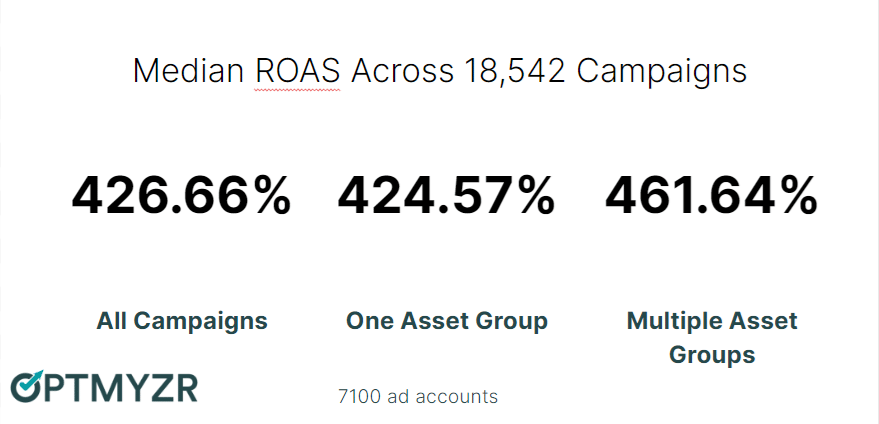
The only conclusive point is that one campaign with one asset group is the most common and least useful way to run Performance Max (regardless of whether you’re on Google or Microsoft).
While achieving success this way is possible, it’s usually a sign of testing the ad type vs strategy. Unless you are working in a super niche space with only one product/service in one market, odds are you will need to go with one of the other three structures.
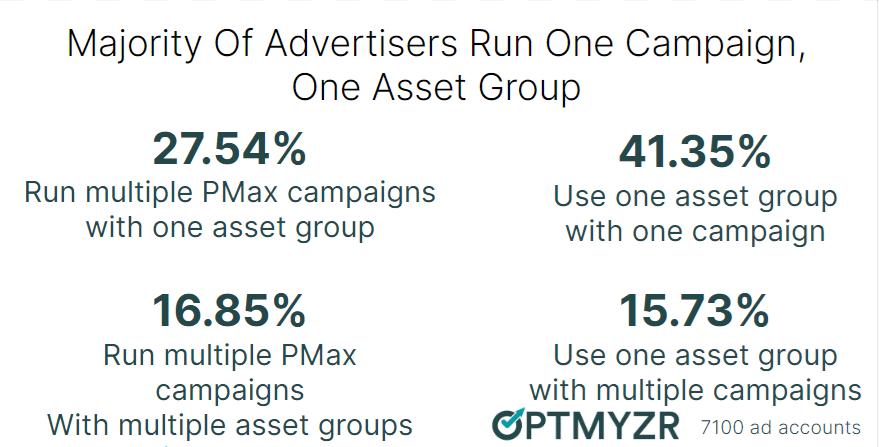
One campaign/multiple asset groups
Going with a single campaign means you only need to worry about one budget. This is great for brands that might be budget-tight and those who need their campaigns to be as data-rich as possible to overcome learning periods.
It’s important to remember that asset groups sharing a budget may not get as much spend allocation as the multi-campaign/single asset group approach. This means you should limit asset groups to those that meet the following criteria:
- Auction prices are fairly similar. While a little deviation is OK, having one asset group with an average CPC of $20 and another with a $2 average CPC is a recipe for imbalance.
- Location/ad schedules are in sync. While a campaign can have multiple time zones, you still want to make sure you’re not mixing too many costs of living and ways of searching.
- Conversion actions are all the same. While you can have different conversion values for ecommerce, the action should be the same. If you need some conversion actions to count for some asset groups but not for others, you may need to split up the campaigns.
Brands with one major market or offering are a good fit for this. The asset groups let them cover the different ways prospects/customers will engage with them, and they can ramp up quickly.
This structure is less suited to brands with multiple locations and/or multiple product/service categories.
Multiple campaigns/one asset group
The big value here is that you can dedicate a budget to the product/service/persona based on its ROI potential. However, since you’re creating multiple budgets, you must set aside a budget for each.
Depending on the nature of your business, this can get expensive quickly. Additionally, if you’re too spread out, you might not be able to get enough conversions to help Performance Max perform well.
Studies have shown that Performance Max needs around 60 conversions per month to thrive and if it can’t get at least 30, it will struggle.
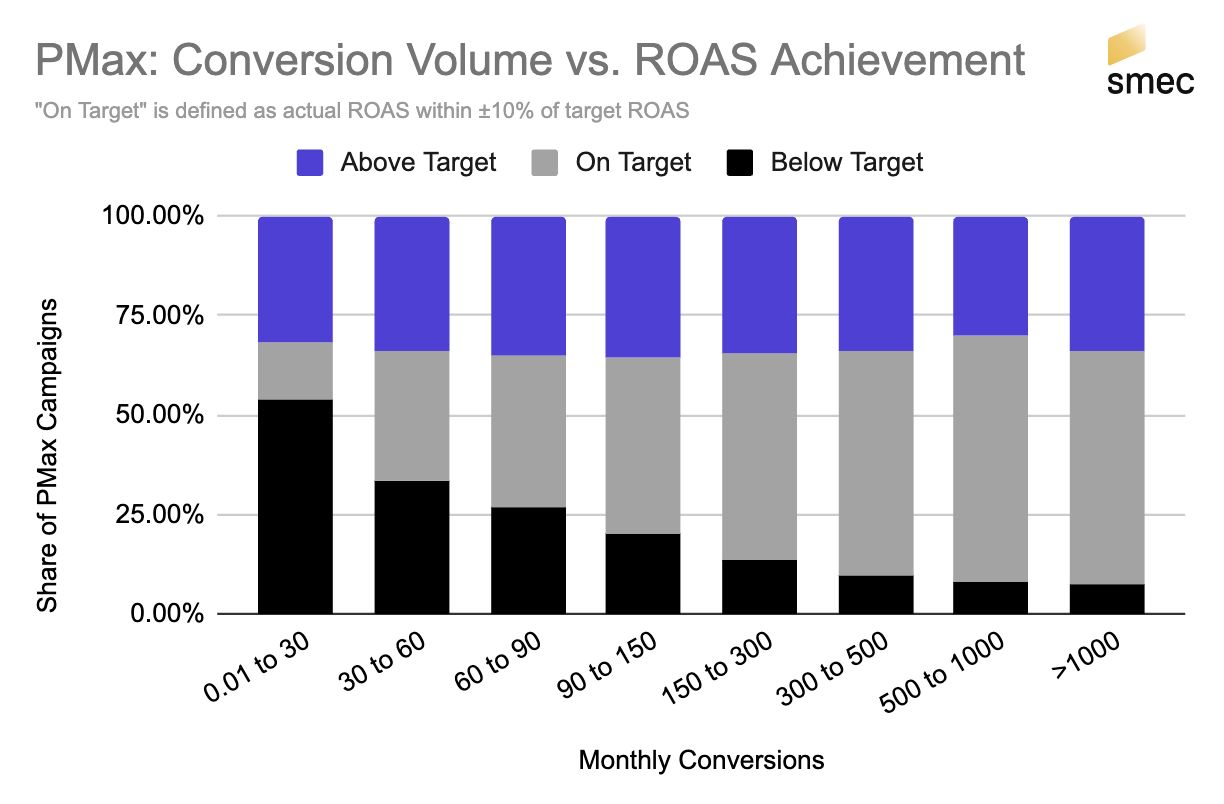
The main considerations for this path are:
- Are the margins drastically different? If you make drastically different amounts or value parts of your business more/less than others, this path will allow you to set a meaningful budget for each part of your business.
- Can you meet conversion thresholds? As the above chart shows, low conversions feed into overall performance issues since Performance Max has to use either Max Conversions or Max Conversion Value.
While this structure will likely suit most brands the best on paper, it really comes down to budget. If you don’t have at least $1,500-$2,000 per month for the campaign, odds are it won’t get enough traction to be meaningful.
Multiple campaigns/Multiple asset groups
This should be the ideal state but must only be used in select circumstances. This is because having multiple campaigns with multiple asset groups invites the budget concern of multiple campaigns and the alignment issue of multiple asset groups.
Still, there are cases where this approach is beneficial and the only way a brand could reasonably cover all the aspects of its brand it needs to market.
Here are the core considerations:
- Do you have the volume to justify this structure? Presumably, you would be setting yourself up with this because you need multiple rounds of campaign-level settings (location, schedule, budget, etc.) and can reasonably group several parts of your business together with their own asset group.
- Know why you have each asset group. Asset groups should represent different creative stemming from a different product/service/persona. If you can’t clearly articulate why you need the asset group, merging it with an existing one might be best.
This structure will suit brands who have budget and a lot of inventory/service areas. Auto, travel and ecommerce are all great fits for this if the monthly spend is there. Otherwise, it’s best to go with a single campaign with multiple asset groups.
Final thoughts on campaigns/asset groups
You can have up to 100 asset groups, but that doesn’t mean you should use all 100.
Targeting in Performance Max is different than in other campaign types, so you really need to look at location, time, and budget as the main driving forces for different campaigns.
Creative: Feed, video and AI
One of the biggest frustrations for “traditional” PPC advertisers is how loose Performance Max’s creative control is. While we can put in creative we want to be included, we cannot control how that creative is applied. This is one of the reasons that feed-only Performance Max became popular – in theory, you’d be able to only serve ads based on your shopping/site feed.
While this tactic came under fire from the ad networks (ad networks will create assets from the feed), many still cling to feed-focused Performance Max.
As the data showed, there wasn’t that big of a difference between feed-only and mixed assets. The bigger issue is that advertisers have a bias toward text ads in the visual era:

Given how much visual inventory (particularly video) is included in Performance Max, it’s no wonder that Google and Microsoft lean heavily on AI to help advertisers close the creative gap.
However, not every brand can just run with AI-driven creative (especially creative that hasn’t been approved by legal and stakeholders). This means one of three things:
- Getting buy-in for creative resources to make visual content other teams/clients can approve of.
- Helping those teams/clients understand that AI-driven creative comes largely from a brand’s own assets, so the ad network is pulling from pre-approved content.
- Missing out on Performance Max placements (and likely getting bad performance) due to the lack of well-crafted visual content.
Should you lean into AI?
The short answer: it depends.
The long answer is that, in most cases, AI will be a value-added service for you, provided you know how to help the AI come up with the right creative.
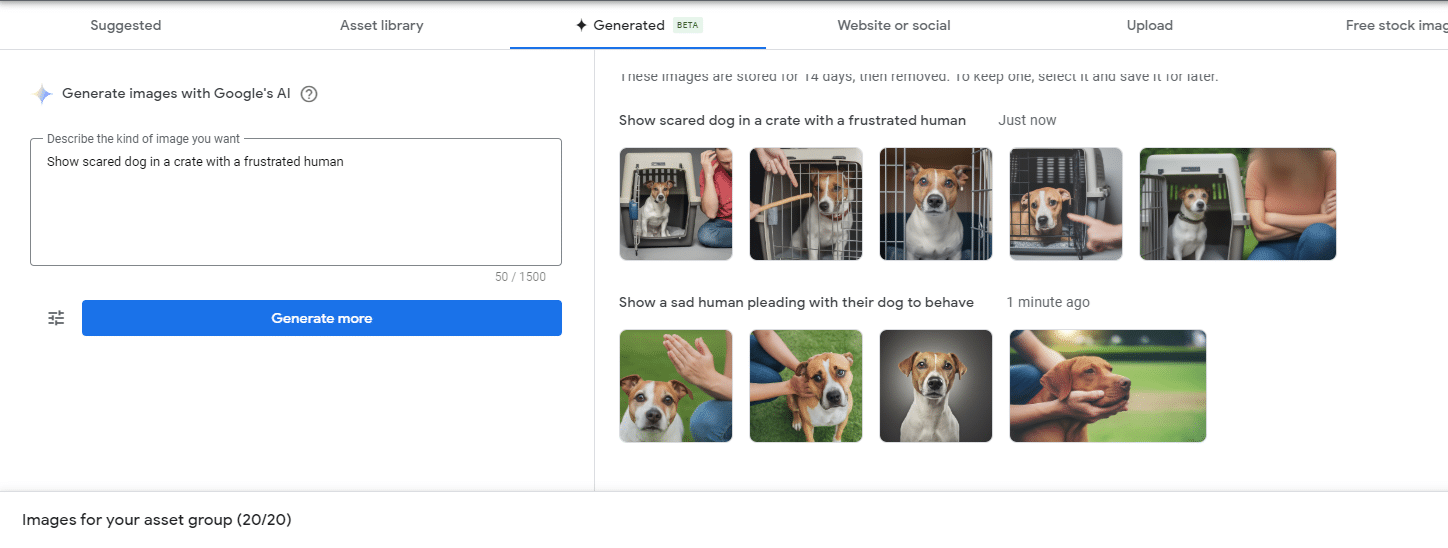
In this example, the goal was to develop assets for a dog trainer. However, the initial prompts asking for exactly what I wanted came back with warnings about animal cruelty (“angry dog barking at frustrated woman in a cage”). While what I ended up with works, it’s not exactly what I wanted.
The core considerations for leaning into AI are:
- Are you allowed to? This is a big one, and if the answer is no, it doesn’t matter how cool the tech is; you need to respect the infrastructure you have.
- Are you under a time/talent crunch? AI is a hero at helping brands who might not have the creative in-house. In most cases, it is faster to generate visual creative through AI than with a human (not as true for text).
The other use for AI is to correct existing assets from your feed. In most cases, this will be a net positive, however, you still should make sure your team approves of the adjustments.
URL expansion and automated assets
There is a big difference between generative AI and auto-created assets/URL expansion.
Auto-created assets take existing assets and existing creative from your content to populate missing assets within an asset group.
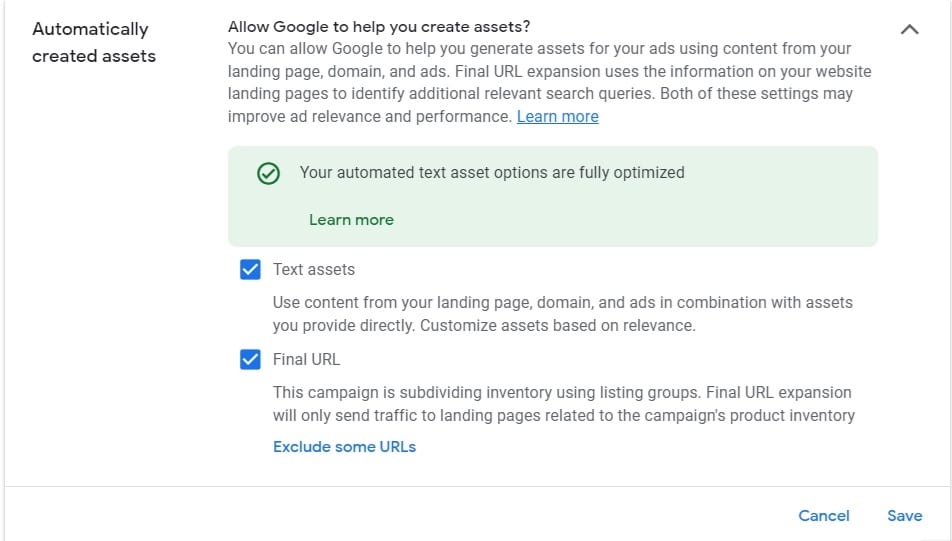
URL expansion allows Google/Microsoft to crawl your site and create ads/spend budget based on other pages that seem relevant. This is essentially DSAs.

Here are the main considerations for both of these creative add-ons:
- URL expansion is almost always a bad idea unless you have your exclusion list read. This is especially important if you have a well-optimized site and don’t want your indexed and followed pages pulled into Performance Max campaigns.
- URL expansion, like DSA, will let you learn how your people search. However, if you mix too many ideas in your asset groups, your data will get muddy. Be sure that you only use this if you have super-segmented asset groups.
- Automatically created assets can be ok, but they often won’t be as clever as the ones you’ll make yourself. For example, if you know you can’t really afford to allocate budget to part of your business, you can add it as a site link or price extension (costs the same as a headline click).
- If you don’t love the assets created, you should not only turn off that function (screenshot below), but you should also do a deep dive into your site. A big source for auto assets is the text from your landing page/website and if the content is bad for ads, it might also be bad organically.
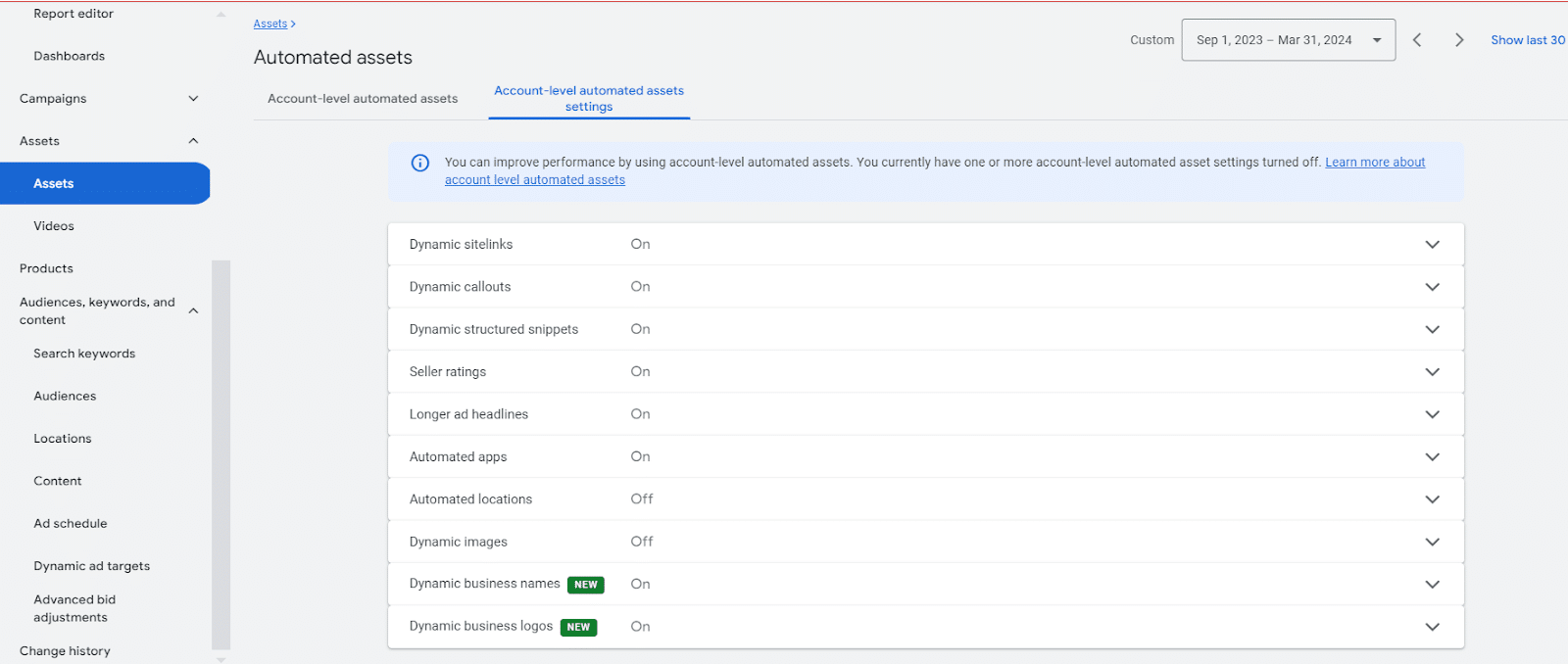
Budgets: Borrow spend or invest more?
Google and Microsoft are the first to own Performance Max, which is designed to complement existing campaigns.
The problem is that brands are used to budgeting a certain amount for their digital marketing, and even if they believe in the promise of the new ad type, they are forced to either spend more or borrow from existing campaigns.
There is no right or wrong answer here other than to honor that each channel has its own auction prices and minimum monthly spend to be viable. If you can’t budget for at least 10 clicks per day, odds are you will fail.
A budget needs to be able to realistically drive at least one lead per day, and if you can’t fit at least 10 clicks in your day, you’re asking your campaigns to perform at a better than 10% conversion rate (which is unrealistic unless we’re talking about branded search).
The case to borrow
One reason it can make sense to borrow over finding a new budget is that you may be finding your siloed campaigns hitting a wall on impression share/market share. Performance Max includes visual content that can add new folks to your search pool and capture folks who don’t want to convert from a SERP path.
To be clear, if your impression share is very low, this is not the approach to take unless you’re committed to Performance Max being your dominant campaign for a while.
The other important note is that if you are running visual campaigns (Demand Gen, video, display), you likely will want to maintain the control you have over frequency/timing. I tend not to suggest borrowing from existing visual campaigns as a rule unless you plan to retire them in favor of Performance Max.
A final note about borrowing: if you’re running broad match, it’s a reasonable test to pause those keywords and move that budget over to Performance Max since the latter will get the same access to broad match signals while letting you access visual inventory. Essentially, you get data acquisition and multi-funnel content.
The case to invest more
It’s hard to find extra budget for tests, especially when the test is something that may seem opposed to conventional management styles. That said, borrowing budget from successful campaigns could hurt performance.
There are a few mechanics about Performance Max that essentially build the case for investing more:
- Search themes (up to 25 per asset group) allow you to test potential exact match keyword concepts before you commit to them in your search campaigns. They tend to take a back seat to exact match in the auction, but can win out over broad/phrase if they semantically match.
- Performance Max removes a lot of human bias from campaign choices. The average account adding in Performance Max campaigns results in 18% more conversions at similar costs, per Google. Whether we buy into that stat or not, there is no denying that Performance Max represents a more “pure” wild and crazy testing campaign.
- Both Performance Max and Search/Shopping campaigns require a substantial budget to succeed. It will be pure waste if you don’t budget enough for the test and decreases in budgets initiate algorithmic learnings that can hurt campaign performance.
Conversions/tracking: How many do you need and are you cannibalizing?
Performance Max only runs on maximum conversions and max conversion value. This means you need to meet certain conversion thresholds.
As we discussed earlier, campaigns getting fewer than 30 conversions in a 30-day period are likely to fail. However, there’s another insidious element to this: how much is Performance Max taking credit for branded conversions, and should you let it?
While the knee-jerk answer is to exclude branded and existing customers, brands with smaller budgets may find themselves in a Catch-22 because they can’t get enough volume without branded playing a role in Performance Max.
There are a few schools of thought here, but all of them require a basic understanding of how audiences and customer lists behave in Performance Max.
Audiences signal mechanics
Audience signals are not the same as audience targeting. It is not possible for a Performance Max campaign to exclusively target a group of people (that’s not what it was designed to do). Rather, they help Google and Microsoft understand who you want to target/find valuable.
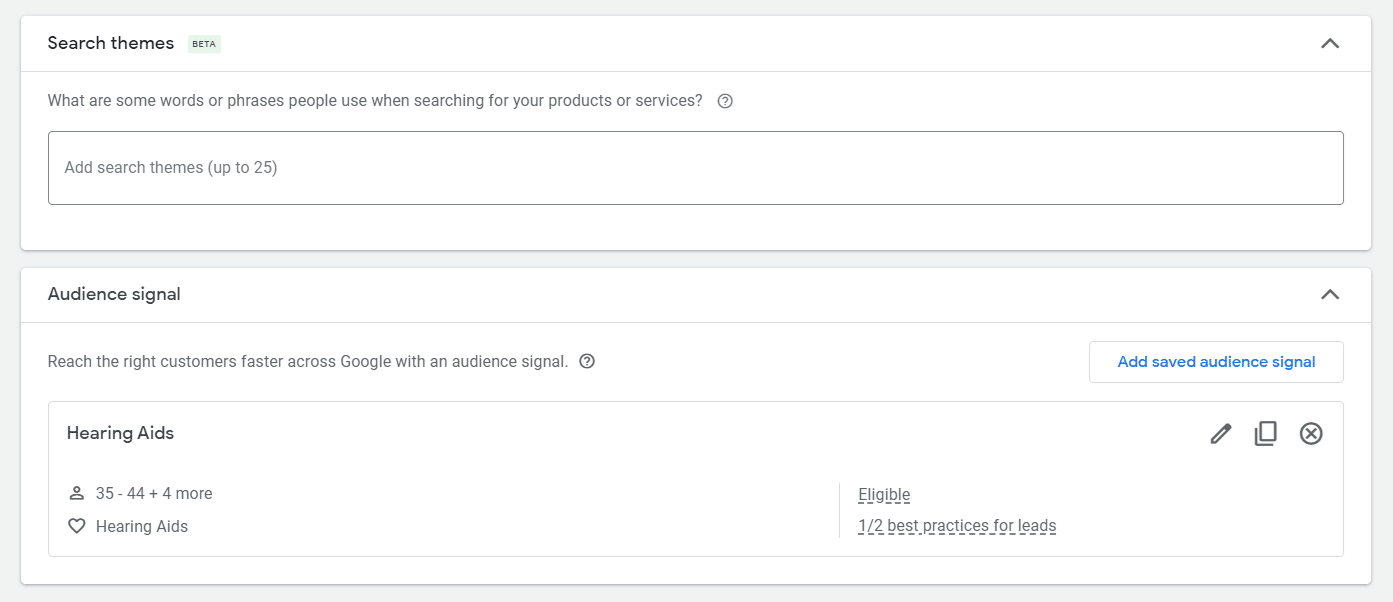
Using first-party audiences can help, but now that more and more markets are forced to adopt consent mode, it’s not reasonable for brands to rely on those as seeds (minimum 1,000 in a 30-day period with 1-2 being added daily).
This is where other audience signals can be really powerful:
- Websites visited/shown interest in.
- In-market and life events.
- General demographics.
These, along with search themes, can help ad platforms better understand who your best people are, giving you a better chance of meeting conversion thresholds.
The other big piece is excluding existing customers. This is the surest way to ensure “branded” traffic doesn’t get in. However, if you treat Performance Max as a lifetime customer value (LCV) tool, you might hurt yourself by doing this.
There are opportunities to rekindle customers and allowing existing customers to get access to some Performance Max budget can help cement you as their partner of choice when they might be looking at your competitors/considering whether to renew their engagement with you.
Both paths have pros and cons, and there is no clear-cut answer. It is important that you honor your strategic choice and take the logistical steps to back it up.
Excluding branded from Performance Max
Keeping branded out of Performance Max is a valid choice. Branded traffic is usually cheaper, has a higher likelihood of conversion, and typically has a strategic budget assigned to it.
Letting it mingle with non-branded is just as bad as the search campaigns that let branded ad groups/keywords mingle in non-branded search campaigns.
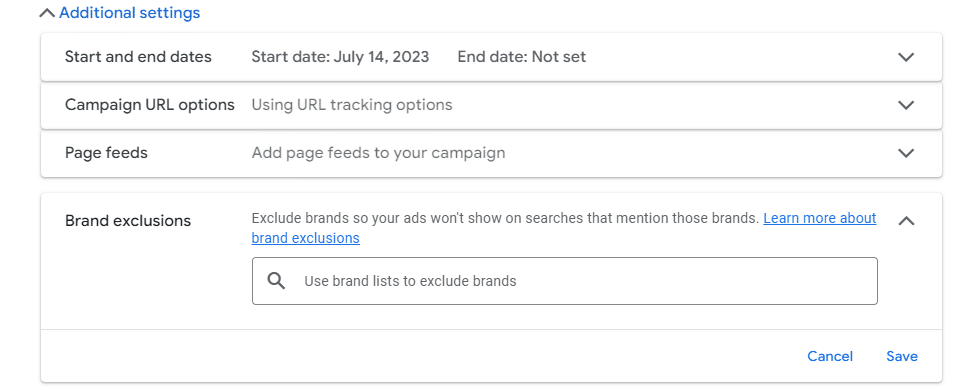
If you opt for this path, be sure that you not only exclude branded terms in the settings, but also exclude existing customers through a user list.
If you go this path, you’ll still want a search campaign targeting branded searches. This way, you can control the budget allocated to it and not cede ground to your competitors.
Allowing branded in Performance Max
The alternative path is to allow all stages of the customer journey. If you do this, you will want to pause branded search campaigns as that will represent a cannibalization risk.
This path is ideal for those who won’t be able to meet thresholds for audience exclusions or conversion thresholds without branded baked into the campaign.
Takeaways
There are no clear-cut answers when it comes to Performance Max because every brand will have different needs. That said, the following guidelines should be helpful in making the right answer for you:
- Big budget brands should consider the multi-campaign approach to funnel budgets correctly.
- An easy way to dominate the competition is through visual creative since most brands gravitate towards “easier” text.
- If you can’t get enough data (conversions and audience lists), you may want to consolidate your structure.
Performance Max has improved a lot, and your results are directly tied to how much effort you put in.